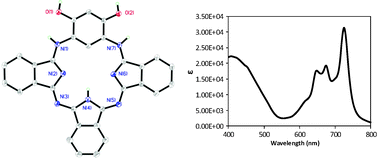Hydroxybenziphthalocyanines: non-aromatic phthalocyanine analogues that exhibit strong UV-visible absorptions†
Abstract
The hemiporphyrazine variants hydroxybenziphthalocyanine and dihydroxybenziphthalocyanine can be generated via sequential

* Corresponding authors
a
Department of Chemistry, University of Akron, Akron, USA
E-mail:
ziegler@uakron.edu
Fax: +1 330 972-7370
Tel: +1 330 972-2531
b Department of Chemistry, Buffalo State College, 1300 Elmwood Avenue, Buffalo, USA
The hemiporphyrazine variants hydroxybenziphthalocyanine and dihydroxybenziphthalocyanine can be generated via sequential

 Please wait while we load your content...
Something went wrong. Try again?
Please wait while we load your content...
Something went wrong. Try again?
R. Costa, A. J. Schick, N. B. Paul, W. S. Durfee and C. J. Ziegler, New J. Chem., 2011, 35, 794 DOI: 10.1039/C0NJ00500B
To request permission to reproduce material from this article, please go to the Copyright Clearance Center request page.
If you are an author contributing to an RSC publication, you do not need to request permission provided correct acknowledgement is given.
If you are the author of this article, you do not need to request permission to reproduce figures and diagrams provided correct acknowledgement is given. If you want to reproduce the whole article in a third-party publication (excluding your thesis/dissertation for which permission is not required) please go to the Copyright Clearance Center request page.
Read more about how to correctly acknowledge RSC content.
 Fetching data from CrossRef.
Fetching data from CrossRef.
This may take some time to load.
Loading related content
